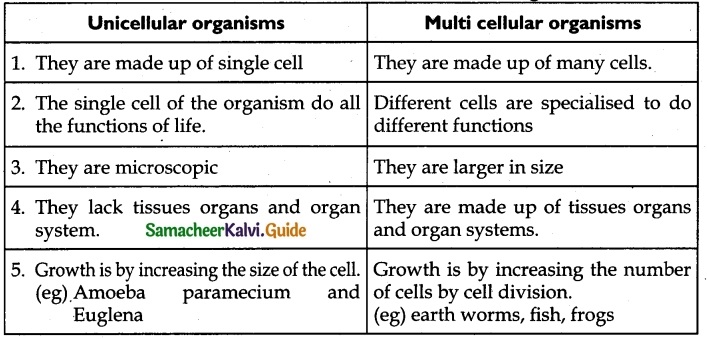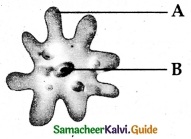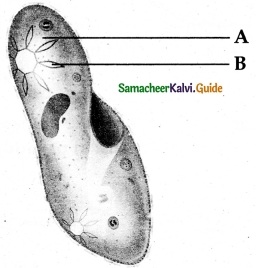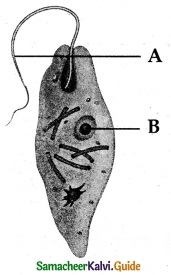Students can download 6th Science Term 1 Chapter 5 Living World of Animals Questions and Answers, Notes, Samacheer Kalvi 6th Science Guide Pdf helps you to revise the complete Tamilnadu State Board New Syllabus, helps students complete homework assignments and to score high marks in board exams.
Tamilnadu Samacheer Kalvi 6th Science Solutions Term 1 Chapter 5 Living World of Animals
Samacheer Kalvi 6th Science Living World of Animals Text Book Back Questions and Answers
I. Choose the correct answer:
Question 1.
The study of living things or organisms is called
a. Psychology
b. Biology
c. Zoology
d. Botany
Answer:
b. Biology
Question 2.
Which of the following are characteristics of living beings?
(i) Respiration
(ii) Reproduction
(iii) Adaptation
(iv) Excretion
Choose the correct sequence
(a) (i), (ii), and (iv) only
(b) (i), (ii) only
(c) (ii) and (iv)only
(d) (i), (iv), (ii) and (iii)
Answer:
(d) (I), (iv), (il) and (iii)
![]()
Question 3.
Lizards breathe through their
a. Skin
b. Gills
c. Lungs
d. Trachea
Answer:
c. Lungs
Question 4.
All animals need _______
(a) Food and water only
(b) Water only
(c) Air, food and water
(d) Food only
Answer:
(c) Air, food and water
Question 5.
Which animal has the special organs of breathing called gills
a. Earthworm
b. fox
c. Fish
d. frog
Answer:
c. Fish
Question 6.
Choose the set that represents only biotic components of a habitat.
(a) Tiger, Deer, Grass, Soil
(b) Rocks, Soil, Plants, Air
(c) Sand, Turtle, Crab, Rocks
(d) Aquatic plant, Fish, Frog, Insects
Answer:
(d) Aquatic plant, Fish, Frog, Insects
Question 7.
Which of the following cannot be called as a habitat?
a. A desert with camels
b. A pond with fish and snails
c. Cultivated land with grazing cattle
d. A jungle with wild animals
Answer:
c. Cultivated land with grazing cattle
![]()
Question 8.
Birds fly in the air with the help of _______
(a) heavy and strong Bones
(b) Soft and thick Bones
(c) Hollow and light Bones
(d) Flat and thick Bones
Answer:
(c) Hollow and light Bones
Question 9.
Paramecium moves from one place to other with the help of
a. Pseudopodia
b. flagella
c. Foot
d. cilia
Answer:
d. Cilia
Question 10.
Kangaroo rat lives In _______
(a) Aquatic habitat
(b) Desert habitat
(c) Grass land habitat
(d) Mountain habitat
Answer:
(b) Desert habitat
II. Multiple Choice Questions Complete the following with appropriate word(s).
- Aquatic, deserts, mountains are called ……….
- Based on the number of cells present animals are classified into ………. and ………..
- Tail of a bird acts as a rudder which helps to ………..
- Amoeba moves with the help of …………
Answer:
- Habitat
- Unicellular, multicellular
- control the direction of the movement
- Pseudopodium.
III. True or False, If False gives the correct answer.
- A habitat is a living or dwelling place of an organism.
- The geographical features and environmental conditions on earth remain the same from one place to another.
- Amoeba is a unicellular organism and moves with pseudopodia.
- Birds can see only one object at a time.
- Paramecium is a multicellular organism.
Answer:
- True
- False – The geographical features and environmental conditions on earth do not remain the same from one place to another.
- True
- True
- False – Paramecium is a unicellular organism.
![]()
IV. Complete the following
- Tropical rain forests, grasslands, and deserts are known as ………..
- Some living things are made of a single cell, they are called a……….. organism
- The breathing organ of a fish is known as ………..
- The lizard ……….. on the ground with its claw on its feet.
- Camel stores ………… in its hump.
Answer:
- habitat
- unicellular
- gills
- walk and run
- fat
V. Very Short Answer Questions:
Question 1.
How do the birds catch their prey?
Answer:
- The prey-catching process depends on their types.
- The aquatic birds with the help of their beaks get their prey sliding upside down into the water.
- The birds of paddy fields get small insects with the help of sharp claws of their limbs.
Question 2.
Where can we see camels in India?
Answer:
We can see camels in the state of Rajasthan:
- The dwelling places of camels
- Jodhpur
- Pushkar
- Pikanur
- Jaisalmer.
Question 3.
Name the locomotory organs of an Amoeba.
Answer:
Amoeba with the help of a finger-like projection called pseudopodia moves from place to place.
![]()
Question 4.
What are the body parts of the snake?
Answer:
Snake’s body is divided into-
- Head
- body
- tail
- Organs on the head-Two eyes, Two nostrils mouth.
Question 5.
Which structure helps the bird to change its direction while flying in the air?
Answer:
The tail helps the bird to change its direction while flying in air.
VI. Short Answer Type Questions:
Question 1.
Differentiate between unicellular and multicellular organisms.
Answer:

Question 2.
Write the adaptive features of polar bears and penguins.
Answer:
Polar bear:
- They have short limbs.
- They have limited body surface to reduce the body temperature
- They have thick skin.
- A polar bear has thick skin for protection against the cold climate.
- They have thick fat deposition under the skin.
- They eat food rich in fat.
Penguin:
- They have a boat-shaped body
- Their feathers absorb sunlight
- They have thick skin.
- They have thick fat deposition under the skin.
- They have short wings to fly above the water and paddle for swimming.
Question 3.
Mention the feature that helps a bird to fly in the air?
Answer:
- The streamlined body shape.
- Their forelimbs are modified into wings.
- They have hollow and light bones for easy flying.
- The body of the birds is covered with feathers.
![]()
Question 4.
What are the different types of invertebrates?
Answer:
- Protozoa ( unicellular)
- Porifera
- Coelenterata
- Platyhelminthes
- Aschelminthes
- Annelida
- Arthropoda
- Mollusca
- Echinodermata
VII. Answer in detail:
Question 1.
Describe the various features which help Camel dwell well in the desert.
Answer:
- The long leg of the camel helps to keep its body away from the desert.
- Camel will drink a large amount of water and store it in the body.
- Camel produces only a small quantity of urine.
- The stored fat in the hump can break down for nourishment
- A camel has large and flat padded feet which help in walking easily on soft sand.
- The long eyelashes and hairs protect its eyes and ears from flowing dust.
- It can keep its nostrils closed to avoid dust.
Samacheer Kalvi 6th Science Living World of Animals Additional Important Questions and Answers
I. Choose the best option:
Question 1.
Which one of the following is a unicellular organism
(a) Fish
(b) frog
(c) Euglena
(d) Lizard
Answer:
(c) Euglena
Question 2.
Polar bear and Penguins dwell in _______
(a) Cold region
(b) Hot region
(c) Cold and Hot region
(d) Forest region
Answer:
(a) Cold region
![]()
Question 3.
The animal lives in water and on land.
(a) Frog
(b) fish
(c) pigeon
(d) camel
Answer:
(a) Frog
Question 4.
Euglena moves with the help of
(a) Flagellum
(b) Cilia
(c) Pseudopods
(d) Legs
Answer:
(a) flagellum
Question 5.
Among the following, which Bird Sanctuary located in Tamilnadu?
(a) Kadalundi
(b) Bharatpur
(c) Vedanthangal
(d) Sultanpur
Answer:
(c) edanthangal
II. True or false. If it is wrong correct it and write.
- Unicellular organisms grow by mitotic division.
- The streamlined body of fish helps in swimming.
- The tail of the bird helps it to control the direction of the movement and balance.
- The hind limbs of birds are modified into wings
- The tail of birds help in controlling the direction of the movement
Answer:
- False – In unicellular organisms, the size of the cell increases as it grows
- True
- True
- False – The forelimbs of birds are modified as wings.
- True
III. Name the parts in a diagram.
Question 1.
In the given diagram name the A and B parts.

Answer:
A. Pseudopodia
B. Nucleus
![]()
Question 2.
In the given diagram Name the A and B parts.

Answer:
A. cilia
B. Contractile Vacuoles.
Question 3.
In the given diagram Name the A and B parts

Answer:
A. Flagella
B. Nucleus.
IV. Give Short Answers:
Question 1.
Give some examples of a unicellular and multicellular organisms.
Answer:
Unicellular: Amoeba, Paramecium, Euglena
Multicellular: Fish, Frog, Lizard, Birds, Man
Question 2.
What is meant by migration?
Answer:
When an animal moves from its location as the season changes it is called migration.
Question 3.
Define Adaptation.
Answer:
The presence of specific body features, for certain habits, which enable a plant or an animal to live in a particular habitat is called adaptation.
Question 4.
What is hibernation?
Answer:
Spending winters in a dormant condition is called hibernation, (eg) Turtle.
![]()
Question 5.
Which part protects the body of fish?
Answer:
Most of the fishes have slippery scales all over the body. It protects the body of fish.
Question 6.
Name any three bird sanctuaries in Tamil Nadu.
Answer:
Vedanthangal, Kodiyakkarai, and Koondhankulam are the bird sanctuaries in Tamil Nadu.
V. Detailed answer:
Question 1.
Give an account of adaptations of birds.
Answer:
- Birds body is covered with feathers that are helpful in flying with reduced weight.
- The mouth is converted into beaks.
- They respire through the lungs.
- Their forelimbs are modified as wings.
- They have hollow bones.
- With the help of a pair of clawed feet, birds can hop move, and run.
Question 2.
Describe various adaptive features of fishes.
Answer:
- The head, trunk, and tail of a fish merge to form a streamlined shape.
- It helps the fish to move through the water easily.
- Gill is a special respiratory organ. It is adapted to breathe in water.
- Most of the fishes have slippery scales. It protects the body.
- It has fins for swimming.
- It has a strong tail. It acts as a rudder to change direction and keeps its body balance in the water.